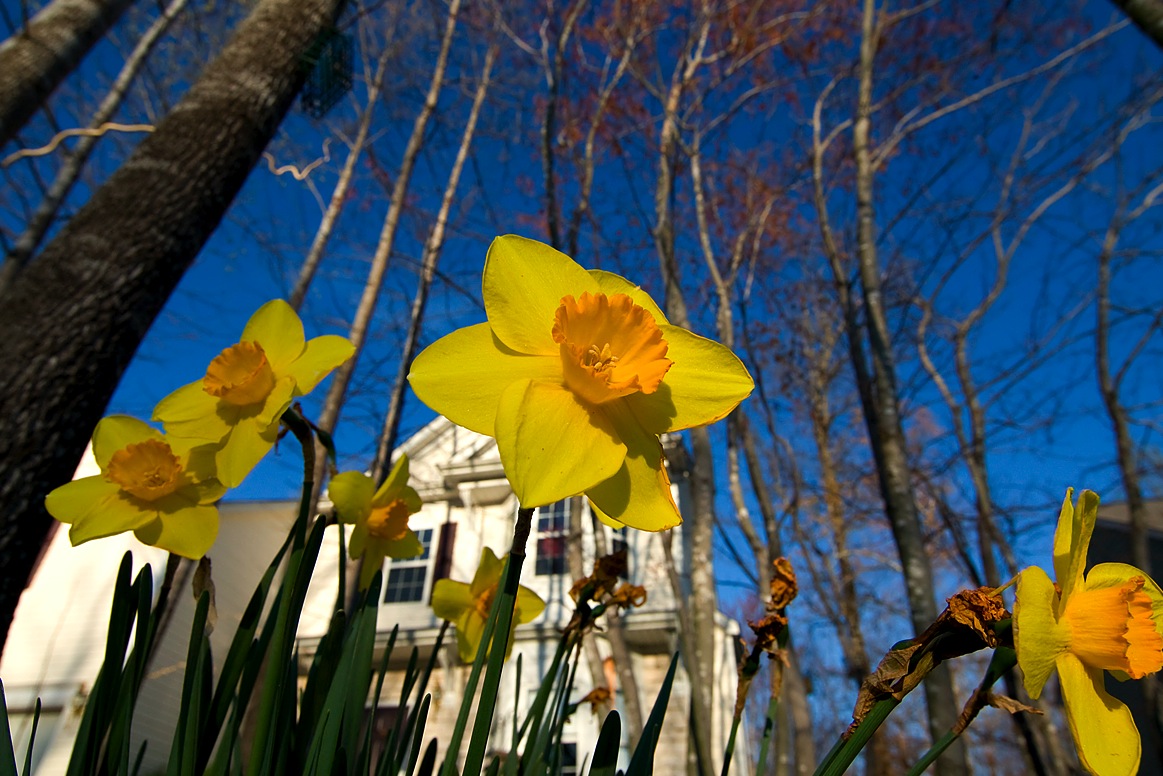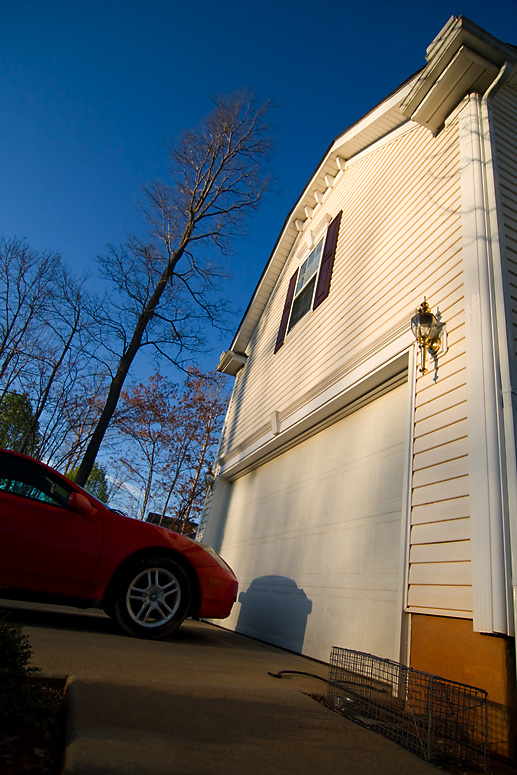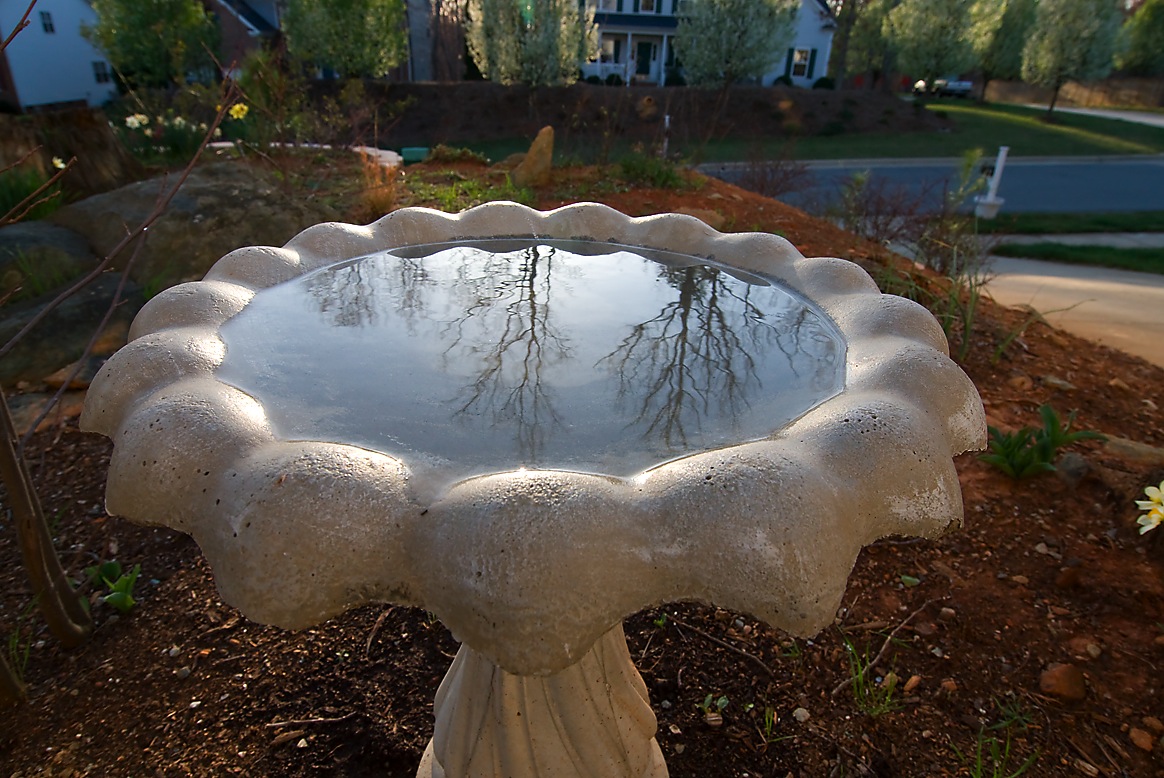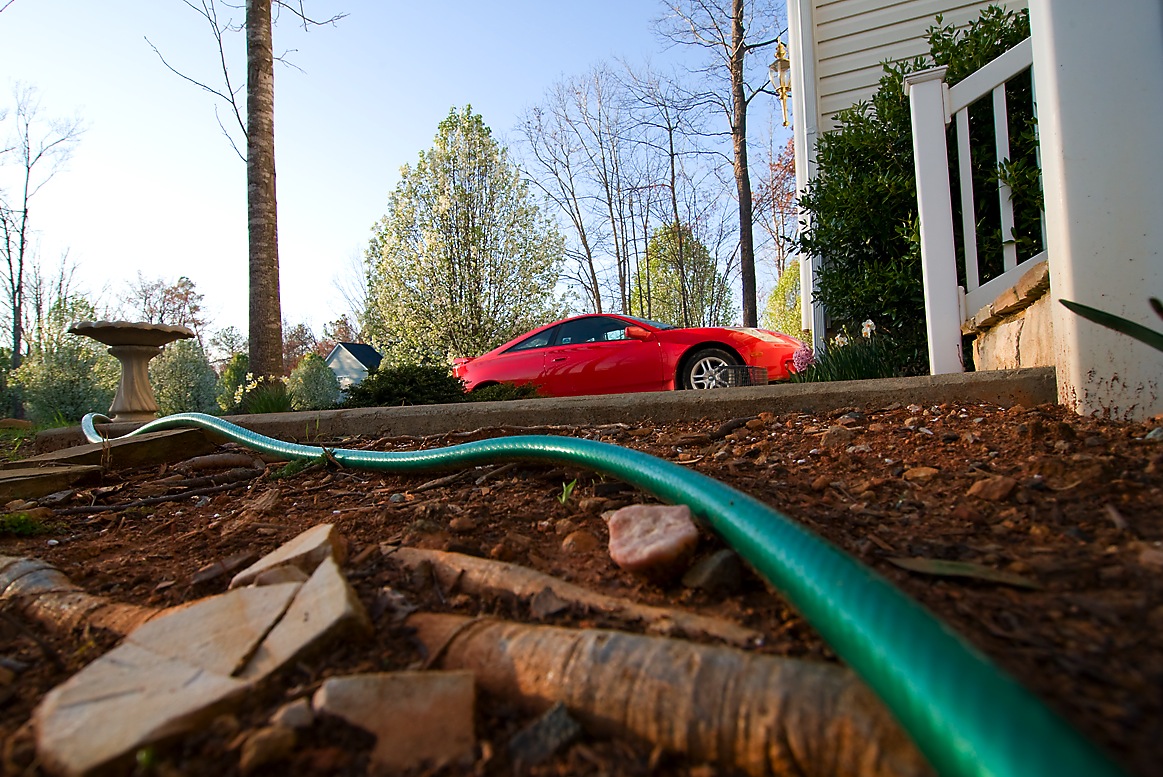As
a bird photographer, the thought of using anything less than about
500mm of focal length rarely even crosses my mind. Indeed, I'm
much more comfortable in the 800-1200mm
range, especially in Spring,
when the warblers are flitting about in the canopy high above me.
There are times, however, when I suddenly realize that I've wandered
into a stunningly scenic natural place which could itself make for a
pleasing photo, if only I had the proper equipment for landscape
photography.
In such cases I either trot out my trusty Sigma 50mm f/2.8 macro lens,
or simply ignore the opportunity altogether,
since the effort of hauling my
800mm lens to such a location generally
leaves me with too little energy to bother fishing out my macro lens
from my camera bag and going through the trouble of attaching it to my
camera.
Lately, however, I've become interested in wide-angle lenses for
landscape photography, in part because I've always been a bit
disappointed by the field-of-view of a 50mm lens on a crop body (1.6x
for my old Canon 30D's and 1.3x for my new Canon
EOS 1D Mark III's),
and also in part because of the interesting "angular" or "fish-eye"
effects I've seen people achieve at some of the super-wide focal
lengths. I decided to try out the Tokina 12-24mm AT-X PRO SD IF
DX lens. I figured 12mm was pretty goddamn wide, and the price on
the lens was reasonably affordable (especially after factoring in the
limited-time rebate).
A quick bit of research on DPREVIEW,
FredMiranda.com,
and other
reputable websites suggested that this was a decent lens. So I
ordered it on Amazon. The
order was fulfilled by an Amazon
merchant, 17th-street Photo,
who expedited the shipment at no extra
cost, so that I ended up receiving the package less than 48 hours after
placing my order. Sweet!
Here's the very first photo I shot with it:

This was taken at the 15mm setting on the lens' zoom, which on my 1.3x
crop body is equivalent to about 19.5mm in full-frame (FF) terms.
As
you can see, even at this moderate zoom setting the images take on a
bit of a "fish-eye" character. (Rest assured that my dog's head
isn't really this big in relation to her body --- it's just an artifact
of wide-angle photography).
The other things you'll notice are that the lens is very sharp, and
that it produces images with excellent
color. This should become even clearer after reviewing the other
photos in this article.

Personally, I've never been interested in owning a fisheye lens.
Fisheye lenses are typically described as being (1) fun, and (2) of
very limited practical use. I tend to agree. Note, however,
that the Tokina 12-24 is not a true fisheye lens, at least not
according to
the product literature. It's just a very wide angle lens.
According to Wikipedia, a fisheye lens is defined as simply a
wide-angle lens in the 15-16mm range. I think there's more to the
definition than this, though. The fisheye photos I've seen
severely distort the rectilinear properties of the scene, so that
straight lines become quite curved, especially around the
periphery. A super-wide-angle lens, on the other hand, shares the
fisheye's tendency to disproportionately enlarge foreground objects,
while lacking the fisheye's tendency toward unnatural curvature around
the edges of the image. In short, a wide-angle lens is simply a
lens with a short focal length --- i.e., one which achieves a wide
angle via lack of magnification, rather than through the sorts of
extreme image distortion employed by a true fisheye lens.
This brings us to the issue of effective
focal lengths. On my crop body (a Canon
EOS 1D Mark III),
which has a 1.3x focal-length
conversion factor, the effective focal lengths of this lens are
approximately 16-31mm. (One can, of course, argue about the semantics
of focal-length
conversion factors versus sensor-based image cropping,
but this would be of little practical value for the present
article). At the low end (16mm), that's definitely within the
fisheye range, as attested by the two photos above.
As you can see from these sample images, at these focal lengths any
sufficiently close foreground object becomes significantly magnified
relative to the background, resulting in big-headed and big-nosed dogs
(or, I suppose, big-headed and big-nosed family members if you were to
take the
lens to your family reunion --- but maybe that wouldn't be such a good
idea...).
More generally, wide-angle lenses tend to distort the proportions,
perspective, and linearity of the elements of the scene you're
photographing. In the photo below, notice how the right edge of
the sidewalk curves toward the center of the image as that edge
progresses into the distance --- in reality, that edge should be
perfectly straight. Super wide-angle lenses are
well-known for this property of non-linear distortion, and indeed are
often used for this very purpose in achieving unnatural perspectives in
images, especially in architectural photography and cityscapes.
Under certain circumstances, such distortions can produce artistic
effects which may be desirable, depending on the intended perspective.
Here's an example: I photographed the Daffodil below at the 16mm
setting while lying on my belly in my front yard. The flower was
no more than a few inches from the front of the lens, and I had the
lens barrel pointed upward:

As you can see, the resulting perspective is quite striking. I
imagine this is what some tiny insect in my front yard might see.
The central flower is quite large, while the other flowers, as well as
most of the rest of the background, are rendered somewhat
smaller. Notice also how the trees (both those to the left and
the thinner ones to the right) tend to curve and angle in strange
ways. Yet, at first glance, the photo doesn't appear unnatural
--- the eye is drawn to the object in the center, while the surrounding
elements, all angled somewhat inward, provide the perspective, which
tells the observer that s/he is observing the scene from below.
I'd also like to point out the excellent color of this photo. The
blue of the sky is quite deep, the yellow is both saturated and
appropriately graduated, and the browns and yellows of the background
objects are entirely natural. No color manipulation has been
added to this image in post-processing whatsoever. For a
third-party (i.e., non-Canon / non-Nikon) lens, I find that remarkable.

In terms of focusing and sharpness,
I can see no flaws whatsoever (though it should be noted that the lens
focuses very slowly, even on a pro body). Although these photos
were taken
with the Canon EOS 1D Mark III, which provides an AF "microadjust"
feature, I've so far not seen any need to adjust this lens in any
way. Images are quite sharp straight out of the lens, and the
color, as I've noted, is vibrant and true. In the image above,
you can see that the sky is quite bright, resulting in some "dodging"
of the trees in the background. As far as I can tell, this is due
entirely to my use of a positive exposure
compensation in the camera
--- i.e., since I'm not using flash for these shots, and since the sun
was getting very low in the sky, I felt the need to increase the
exposure in order to avoid under-exposing the subject's face.
This resulted in over-exposure of the background, with the resultant
"dodging" of the trees. I don't think the lens can be blamed for
that.
So, how does this lens perform for landscape photography? After
all, that's what I am hoping to use it for in the first place!
Well, I'm not sure yet. I don't live near the Grand Canyon, so
how sure can I really be? In lieu of the Grand Canyon, here's a
tree in my front yard:

Note that this photo was taken in portrait format --- i.e., by
holding the camera at a right-angle to its normal orientation, which is
called landscape format, or
landscape orientation. Wide-angle lenses are indeed somewhat of a
misnomer, since they can be used not only to take wide-angle photos, but also tall-angle photos, as illustrated
above. The nice thing about a tall-angle perspective is that you
can get both the close foreground in frame (i.e., the grass at your
feet) and the deep blue sky high above your subject. It's a
format that I think is too often overlooked. Indeed, I've often
heard it said that publishers and photo-editors continually lament the
paucity of vertical-oriented
photos, since these tend to fit most readily into published formats
(i.e., magazine covers and the like).
Now, if you're as objective an observer as am I, you'll no doubt notice
that the trees in the image above seem to slant rather unnaturally in
toward the center of the image. That is indeed a property of the
wide-angle view. As a photographer, however, you need to keep in
mind that much of what you notice when inspecting photographs falls
entirely under the radar of the casual observer. Although the
slanting trees in the above image may offend you as a photographer (or
perhaps even as a botanist?), it is their effect on the experience of
the novel observer that must be taken into consideration in evaluating
the
merits of an image as viable art.
Here's an image taken at the same focal length, but from about 20 feet
further back (i.e., using the "foot zoom"):

Although less leaning of the trees
is apparent, there is still a fair amount of nonlinear distortion
evident. You can see this most clearly in the proportions of the
automobile in the foreground. If you look at the driveway, it
appears a bit long (I know for a fact that it's shorter than it
seems). Also, if you look at the
street in the background, it stretches away quite nicely.
From firsthand experience, I can tell you that the pickup truck around
the corner isn't as far away as the photo would suggest, though I find
this image quite pleasing in terms of the way it has stretched out the
topological contours.
If you're a discerning viewer you've also noticed the vignetting at the top of the image
--- i.e., the slight, dark banding along the top edge of the
image. This leads us to a very important point regarding this
lens. Tokina's product literature is quite explicit in stating
that this is an APS-C lens. That means that it's designed
specially for crop cameras in the 1.5x to 1.6x range. In the case
of Canon DSLR cameras, this means that the lens is well suited for use
on a 10D / 20D / 30D / 40D camera body. For full-frame bodies
such as the Canon EOS 5D or the Canon EOS 1Ds Mark III, it's not
recommended.
 So,
what about the 1.3x crop bodies
like the Canon EOS 1D Mark II or III?
Well, there's good news and there's bad news.
The good news is that all of the
images featured in this article were shot
with a 1.3x crop body. That should at least convince you
that the lens has some utility even when used on a non-APS-C sensor
body.
The bad news is that all of these
photos were shot at focal lengths of about 15-16mm. Focal lengths
higher than this (i.e., 17-24mm) worked perfectly fine, though I didn't
include any examples here because I was fixated on the effects of
ultra-wide-angle photography. The real bad news is that focal
lengths of 12-14mm result in a thick black band of vignetting around
the periphery of the image when used on a 1.3x crop camera, with some
slight vignetting apparent to the experienced observer even at 15mm,
unless corrected with software.

As an example, notice in the image
above how the top-right corner of the photo exhibits a dark
masking. There is also a barely-discernible band across the top
edge of the image. This photo was shot at 15mm. Note also
that this is a zoom lens, so that focal lengths cannot be precisely
determined to the millimeter, since the zoom setting is a
gradually-varying
quantity. On a 1.3x crop body, avoiding vignetting with this lens
can be achieved by keeping the zoom setting strictly above 15mm.
I've yet to shoot a photo above about 16mm or 17mm, since I like this
range of focal lengths so
much.
So, what am I losing by
not being able to use this lens in the 12-14mm range?
Well, first of all, in full-frame (FF) equivalent terms, this really
means that I can't use this lens to achieve absolute focal lengths
below 19.5mm (on my 1.3x crop-factor body). What I was pleased to
discover, upon performing a fairly extensive internet search for
landscape photography tutorials, is that most landscape photography is
performed in the 20-28mm range, with a special emphasis on focal
lengths hovering around 24mm (in FF terms). Indeed, as of just a
few years ago, lenses shorter than 20mm were quite rare, and were
certainly not the mainstay of hordes of landscape photographers.
Thus, for those using the Canon 1D Mark III, the range of usable focal
lengths available with the Tokina 12-24mm lens is entirely adequate.

An important point illustrated by
the image above is that when shooting with a wide-angle lens, angular
distortions tend to be most acutely manifested when shooting at an
angle to the structures being photographed. In this example, you
can see that I was tilting the lens not only at an angle to the horizon
(i.e., explaining why the car isn't perfectly vertical), but was also
angling upward a bit, toward the sky. From my limited
understanding of the way that these lenses operate, I've gathered that
the greatest distortions in perspective are obtained by angling the
lens with respect to the long axis of whatever is being
photographed. In this case it was a garage, though you can see
that the trees in the background were even more severely affected.
Keep in mind, though, that at the
end of the day what matters most is the impression made on your viewers
when you attempt to utilize the distortion effects of wide-angle
lenses. A wide-angle lens can provide not only a wide-angle view,
but also a view which emphasizes distances, and possibly even radically
distorts them. In the image below I've used the latter effect to
stretch out the extent of a common garden hose. Though the
distances involved were rather less than that suggested by the image,
the effect of the hose extruding prominently from the bottom-right
corner of the image to the seemingly distant birdbath at the extreme
left provides both a distance scale and a theme to the image. In
the case of the Tokina 12-24mm EF-mount lens, providing such a
perspective while also retaining sharpness and color is easily achieved
without any special post-processing.
Although I'm not a expert on wide-angle lenses, I've done enough
forum-lurking to know that many wide-angle lenses (even expensive ones
such as those produced by Canon) induce distortions in
the edges of images, either chromatically
(i.e., involving unnatural
color separation) or otherwise (the most typical being the unnatural
"stretching" effect that can be achieved either by using an extremely
cheap wide-angle lens or by utilizing long extension tubes or a
title-and-shift lens). As a case in point, if you look at the
image above, you'll note that while the edges are slightly out of
focus, they exhibit no chromatic distortion, and admit very little
indication of any stretching.
What has astounded me, after viewing many examples from other lenses,
is the near total lack of any edge distortion from the Tokina 12-24mm
lens. Yes, the landscape and its horizontal/vertical reference
lines tend to be distorted in the predictable ways for wide-angle
lenses. And of course the edges of the image when shot at f/4 (as
many of these images were) will be out of focus due to the limited
depth of field. But in terms of things like chromatic aberration
and "stretching" at the extreme edges of the image, I find very little
evidence of either.

In summary, I
am bound to say that the Tokina 12-24mm lens provides outstanding
wide-angle performance even when mounted on a 1.3x (i.e., non-APS-C
format) camera body. Note that Tokina explicitly states that this
lens should be used only on APS-C cameras. The fact that the lens
continues to perform well on 1.3x crop-factor (APS-H) cameras despite
this
warning only serves to underscore the quality and utility of this
lens. Note that while on a 1.3x crop-factor lens only the 15-24mm
range are useful without vignetting, at the low end of the range this
is essentially the same as on a 1.6x (i.e., APS-C) body, so that by
using the lens on a 1D body you will generally lose little if anything
at the wide end. Together with the affordable nature of this
lens, I think that makes this lens an ideal option for those with 1D
bodies.
One thing I've failed to note up to this point is the amazing build
quality of this lens. Others have described the build quality as
"tank-like". I don't disagree. It is both heavy and
solid. On the downside, the focusing is slow, even on a pro body
like the 1D Mark III. Also, the lens hood seems a bit
inconvenient, though for me that's because I like to keep all my lenses
packed tightly into a portable lens case. The lens does not come
with a lens case of its own.
Nevertheless, I'm very, very satisfied with this lens, and can
wholeheartedly recommend it for other 1D owners.
|
|















